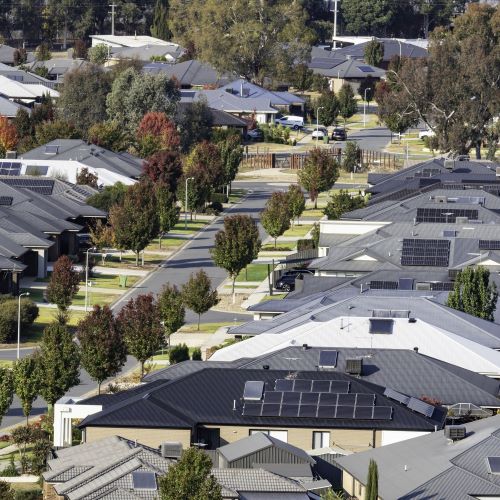15 August 2025

Australian researchers have found that households with solar panels could boost their returns by selling surplus power directly to their neighbours, known as peer-to-peer (P2P) energy sharing, helping to stabilise the electricity grid and negotiating a better price than retailers currently offer.
With solar panels installed in almost 40% of Australian houses (4.1 million homes), the electricity grid is now overloaded with excess energy, driving down the feed-in tariff for most households, with some now questioning the economic value of solar.
In a bid to make it more attractive and encourage the uptake of renewable energy, the Federal Government has recently implemented a $2.3 billion scheme to subsidise the installation of home batteries, but a new study shows that adding battery storage doesn’t always deliver extra benefits.
A collaboration between the University of South Australia (UniSA) and Deakin University has compared four different energy models that could help households and energy policymakers design more efficient, community-based solar systems.
The research, published in Renewable Energy, explores the technical and economic benefits of integrating batteries and P2P energy sharing into grid-connected residential photovoltaic (PV) systems.
Using real-world data from a 10kW solar-powered home in Geelong, the study simulated energy generation, consumption and sharing across four models over 12 months, including interactions with three neighbouring consumers.
The models included:
- Peer-to-grid (P2G) – exporting excess energy to the grid
- P2G with batteries – storing surplus energy before selling to the grid
- Peer-to-peer (P2P) – sharing surplus energy with nearby householders at an agreed price
- P2P with batteries – storing energy for self-use, then sharing remaining surplus with neighbours
Lead author UniSA researcher Dr Kevin Wang says the findings show that P2P energy sharing delivers significant benefits compared to traditional grid export arrangements, particularly when feed-in tariffs are low.
“Under current conditions in Victoria, the feed-in tariff is less than 5 cents per kilowatt hour, while the retail price is around 28 cents. Selling surplus PV energy directly to neighbours at a mutually agreed price in between can be more profitable for solar householders and still cheaper for buyers,” Dr Wang says.
Local P2P energy sharing also improves grid stability, balancing supply and demand, because less surplus energy is exported to the grid, which is primarily built to distribute power rather than receive it.
The results showed:
- Batteries boost self-consumption but not profits: Adding a 5kW battery lifted self-consumption to 22% and reduced grid imports but did not help the neighbour. Due to the high initial purchase cost of batteries, the householder did not generate any profits.
- P2P energy sharing reduces grid reliance: Neighbours who participated in peer-to-peer energy sharing saw their grid electricity consumption drop by more than 30%
- No batteries or P2P energy sharing: The householder exported almost 12,800 kWh to the grid annually, with self-consumption rates of just 14.6%
- Batteries plus P2P energy sharing: P2P energy sharing with a 5kWh battery raised self-consumption to nearly 38% but reduced the surplus available to neighbours because battery charging took priority.
- Optimal battery size matters: The shortest payback period – 12 years – was achieved with a 7.5 kWh battery under the P2P model.
- Sensitivity to market: The study’s sensitivity analysis revealed that factors such as equipment costs, discount rates and energy sharing prices significantly influence the financial viability of PV-battery systems.
“Our modelling revealed that under current conditions, P2P energy sharing coupled with a 10kWh battery could deliver the highest return – $4929 – for solar owners over 20 years,” Dr Wang says.
“In contrast, all peer-to-grid scenarios resulted in negative returns over the same period due to low feed-in tariffs and high battery costs.
“Battery size proved critical. Systems with oversized batteries saw returns diminish due to higher capital and maintenance costs and reduced surplus energy.”
Co-author Professor Chunlu Liu from Deakin University says the study highlights a trade-off between battery use and community sharing.
“When batteries are used, they benefit the solar owner by reducing their grid reliance, but this can limit the amount of energy shared with neighbours because they are fully charged before any surplus energy is shared. The challenge is to find a balance that works for everyone,” Prof Liu says.
The researchers suggest that further gains in solar self-consumption could be made by integrating other technologies, such as heat pumps or thermal storage, to absorb excess PV energy that would otherwise be exported.
With Australia’s solar uptake the highest in the world, the authors say that models like P2P energy sharing could help relieve pressure on the grid while improving the economics of home solar.
“Our analysis shows that if P2P energy sharing prices are set between the feed-in tariff and retail rates, both sellers and buyers can come out ahead,” according to co-author Professor Mark Luther. “But market rules and technical systems need to support these transactions at scale.”
The team hopes their work will inform policy and investment decisions as the energy sector transitions to decentralised, low-carbon systems.
‘Technical and economic analyses of grid-connected residential PV considering batteries and peer-to-peer energy sharing’ is published is authored by Kevin Wang, Mark Luther, Peter Horan, Jane Matthews and Chunlu Liu. DOI: 10.1016/j.renene.2025.123494
…………………………………………………………………………………………………………………………
Contacts for interview:
Researcher contact: Dr Kevin Wang E: KevinZheng.Wang@unisa.edu.au
Media contact: Candy Gibson M: +61 434 605 142 E: candy.gibson@unisa.edu.au




